Places I Love: A Valentine’s Day Celebration
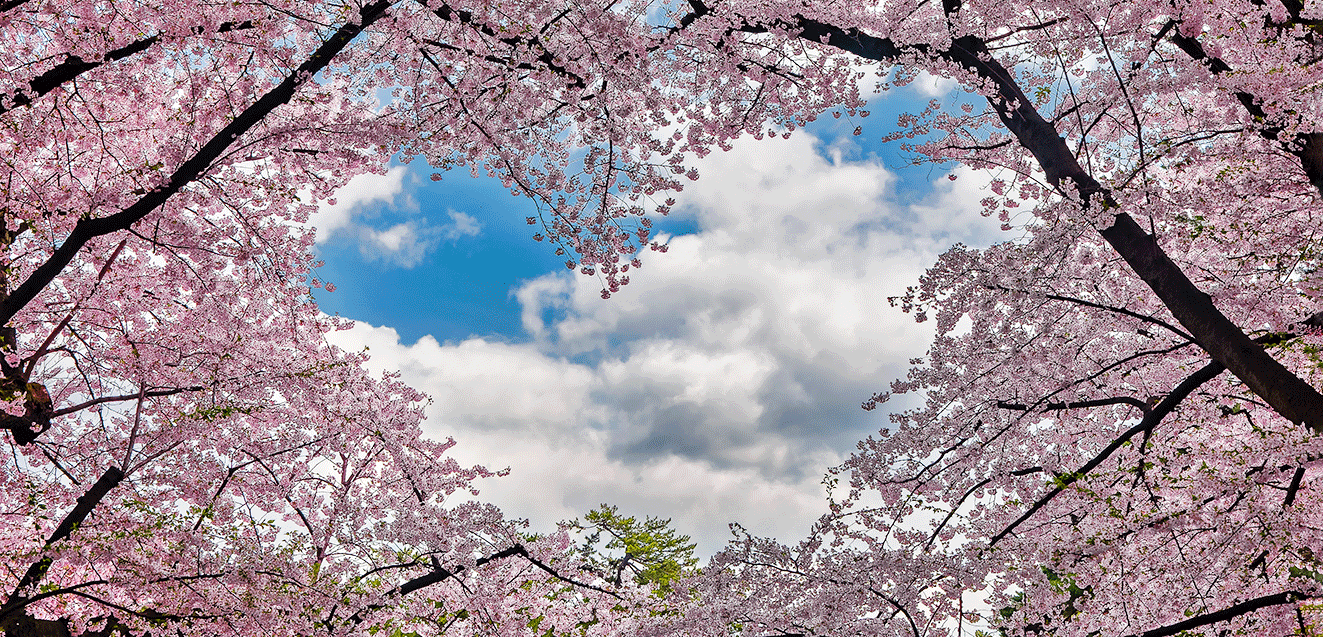
For this month’s Wanderlust column, in honor of Valentine’s Day, I wanted to write about a lesson that has threaded through my life for the past five decades: Travel makes me fall in love with the world.
Contemplating this theme led me to think about my two upcoming GeoEx trips, to Japan in March and April and to Greece in May. And just imagining these trips immediately inspired the frisson of expectation, shivering sense of wonder, and palpable promise of possibility that I’ve felt ever since my first adventure abroad fifty years ago, and that I still feel before every journey.
But how to capture the romance these places hold for me?
After a few days fruitlessly trying to write about both countries in their entirety, I remembered a favorite lesson: Less is more. And I asked myself: Of all the wonderful places you’re about to visit, what are the two you’re especially excited for?
The answers came immediately.
And so, here are my Valentine’s Day celebrations of two places I adore: the island of Delos in Greece and the Ryoanji temple rock garden in Kyoto, Japan.
What do I love about visiting Delos?
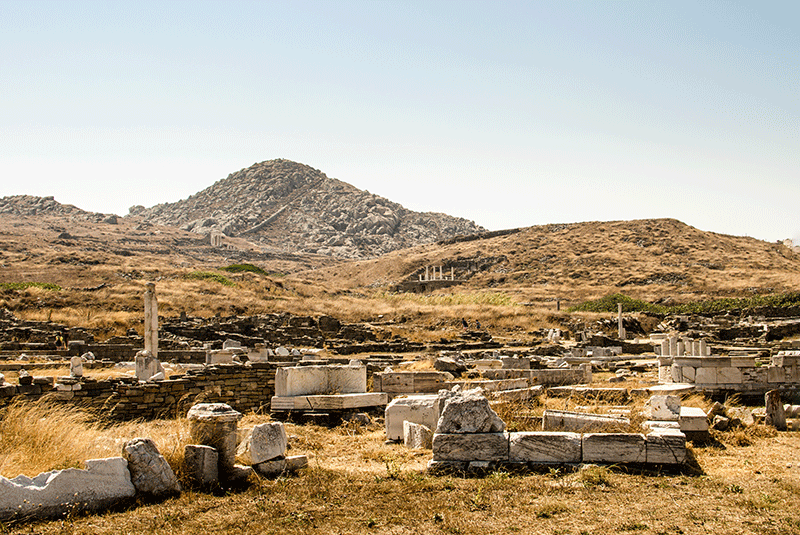
1. Its purity and simplicity
I first visited Delos 49 years ago, in the middle of a post-undergraduate year teaching on a fellowship at Athens College. After numerous adventures in other parts of Greece, the first thing that struck me about Delos was its stark simplicity and purity.
As I wrote back then:
“There are no tavernas, no discotheques, no pleasure boats at anchor; nor are there churches, windmills, or goatherds. Delos, three miles long and less than one mile wide, is a parched, rocky island of ruins.”
Last summer, half a century later, I was finally able to return to Delos, and it was still a parched, rocky island of ruins: sere, stark, and mesmerizing in its simplicity. As I wandered its paths and hills, the absence of distractions impelled me to focus: this fluted bone-white marble column; that stunning multi-colored mosaic; these rugged remnants of a temple; that solitary, blazing red poppy; the surrounding, shining Aegean Sea.
This stark simplicity invested every artifact — stubby pillar, cracking archway, broken bit of statue, chiseled inscription — with a palpable presence and an alchemical clarity. The very air hummed with antiquity.
2. Its mythological connection
In Greek mythology, Delos was originally a roving island when Leto, mistress of Zeus, landed there racked with birth pains. Poseidon anchored the island in its present position while Leto brought forth Artemis, the goddess of the moon and the hunt, and Apollo, the sun god and protector of light, art, and prophecy. Apollo eventually became the most revered of the Greek gods, and religious devotion, coupled with the island’s central, protected situation in the Aegean Sea, established Delos as an important religious sanctuary.
Delos had to remain pure to continue serving its religious role, and in the 6th and 5th centuries BCE, the Delphic Oracle accordingly proclaimed that no one should die, fall sick, or give birth on the island. Just as Poseidon had anchored the island geographically, the Oracle’s prophecy anchored the parched pinprick of land as a uniquely sacred and untouchable place.
As a result, even today this mythology surrounds you, enwraps you, as you explore Delos. As elsewhere in Greece but with an even more focused energy here, the mythical infuses everything: You walk in myth and breathe in myth; it is part of the island’s atmosphere.
3. Its rich history
Because of this mythological status, astonishingly enough, from the 8th century BCE to the 1st century BCE, diminutive Delos was the thriving center of the Mediterranean world, first as a religious center and later as the religious, cultural, and commercial hub of an empire that stretched from Italy to the coast of Asia Minor.
It’s mind-stretching to see the evidence of this as you wander among the ruins, discovering an Egyptian temple and statues, a Syrian sanctuary, Roman villas and Latin inscriptions, Thracian shrines — all vivid testaments to the bustling conjunction of cultures that once bargained, beseeched, and banqueted here.
4. Its isolation and solitude
Another quality I love about Delos is its isolation. The island is uninhabited, and the only reliable regular public transportation is a ferry from Mykonos. Otherwise, you need to have your own yacht to visit. On my day-long exploration last summer, I never saw more than two dozen visitors, and in the afternoon, I was able to wander around the ruins absolutely alone for two hours. It felt like my secret place.
5. The way it transports you through time
This isolation and solitude, combined with the extensiveness and variety of the ruins themselves, lend the site a special poignancy, propelling you through time.
This is how I described my first exploration 49 years ago:
“Wandering the ruins of this once-boisterous center, I found temples both plain and elegant, Greek and foreign; massive marketplaces studded with pedestals where statues once stood, now paved with poppies; a theater quarter with vivid mosaics depicting actors and symbolic animals and fish; a dry lake ringed with palm trees; a stadium and a gymnasium; storehouses and quays along the waterfront; and an ancient suburb where merchants and ship captains once lived: the haunting skeleton of a Hellenistic metropolis.”
That was my morning’s exploration. After a noontime rest, I ventured back into the ruins and was rewarded with an even more transporting experience.
“I walked into the ruins, following the wide central avenue, the ‘Sacred Way,’ toward the waterfront, the theater district, and the hillside temples. On my way I passed columns carved with line after line of intricate symbols; sacrificial altars; huge cisterns for storing rainwater and oil; and vast foundations outlining meeting halls and marketplaces by the wharves. I explored the remains of private houses, passing from room to room, trying to imagine where their inhabitants had cooked, eaten, and slept, awakened from my reverie only by an occasional spider web or lizard trail. As I walked on and the setting sun cast the halls and walls in an orange-pink light, the ruins seemed to take on a strange life all their own.”
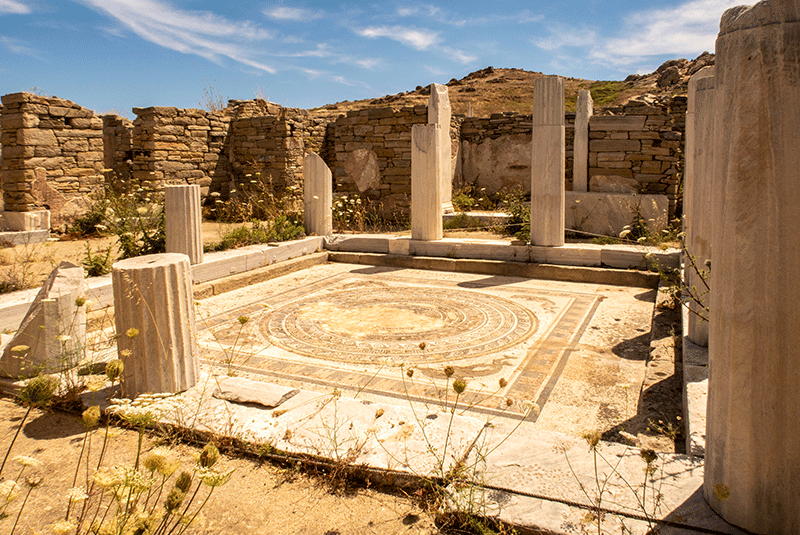
6. Its timelessness
“What had been eerie desolation,” I continued in that early description, “became an intense timelessness, a sense of communion with other peoples and other eras. My boots crossed rocks other sandals had crossed; my hands touched marble other hands had touched. When I reached the mosaics, they seemed a living thing, green-eyed tigers and blue dolphins, flowers of every shape and color, the same to me as they were to the countless merchants and artisans who had admired them centuries before.”
Last summer, I experienced this same sensation:
“I’ve finally returned, half a century later,” I wrote in my journal, “and my boots again walk rocky paths other sandals have walked; my hands touch cool, rough columns other hands have touched. I am looking at the exact same mosaics I saw five decades ago — green-eyed tigers and blue dolphins, flowers of every shape and color — and once again, they seem living things, transporting me out of time.”
7. Its sacred feeling
All these elements combined — the Delphic Oracle’s proclamations, the astonishing history, the fluted, bone-white temple columns and vivid, multi-colored mosaics, the lack of inhabitants and tourist throngs — give a uniquely sacred feeling to Delos, a timelessness that at once makes me feel the suffusing, enfolding presence of the past and a threading connection to the long, unfinished path of human history.
After my first visit, I felt like I had left a piece of my heart and soul there. My return last summer felt like a long-awaited embrace, a completion, a welcoming home.
What do I love about Ryoanji?
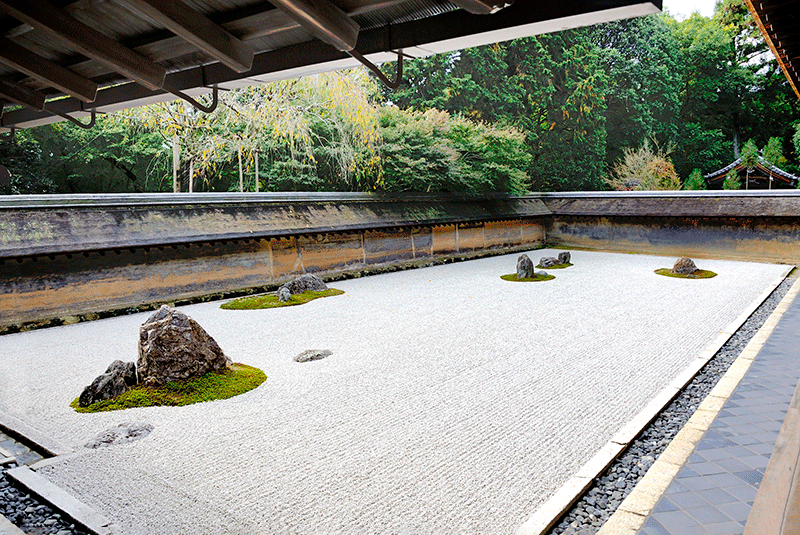
1. Its purity and simplicity
The rock garden at Ryoanji is wonderfully spare and simple; its very appearance is at once calming and slowing. The garden was built in the 15th century, probably by a renowned, Zen-influenced artist named Soami. It is considered a masterpiece of the karesansui (“dry landscape”) garden style. Roughly 30 feet by 80 feet, the garden consists of fifteen irregularly shaped rocks of varying sizes, some surrounded by moss, arranged in a bed of river stones that is meticulously raked by monks. A low earthen wall surrounds the garden on three sides, overhung by a narrow, beamed wooden roof; on the fourth side, wooden steps lead to a wide wooden verandah and the main building of the temple itself. Beyond the wall are cedar, maple, pine, and cherry trees.
2. Its brilliant design
Look long enough and closely enough, and you can see how the river pebbles have been meticulously raked in circles around the rocks, and in straight lines in the open areas; and how these lines stop without a misplaced pebble when they touch the circular patterns, and then resume unchanged beyond them.
You can see how the pockets of moss have filled the pocks in the stones; how the glazed wall that surrounds the garden is rough and textured, like a piece of priceless pottery; how the garden’s design subtly embraces the cherry, maple, cedar, and pine trees beyond the wall; and how the pebbles echo the sky, the moss echoes the trees, the wall and roof balance the platform, and the rocks seem to emanate a web of intricate, tranquil tension within the whole.
3. Its elusive, enigmatic enchantment
I first visited Ryoanji 47 years ago, when I was teaching in Tokyo on a two-year fellowship. On that first visit, I felt that the rock garden was an enchanting enigma, telling me something I couldn’t put words to, and ever since then, visiting Ryoanji has become a sacred rite of my annual Kyoto pilgrimage.
Through the years, I have seen Ryoanji in spring, when the cherry trees bloomed, and in fall, when their branches were bare; in winter, when snow covered the moss, and in summer, when the cicadas buzzed beyond the wall. I have been there among schoolkids in black caps and black-and-white school uniforms, studying me while I studied the garden, and adults in shiny cameras and kimonos, clicking and clucking and walking on. I have been there among giggling teenagers and gaping farmers, selfie-snappers and rock-counters (“one, two, three, quatre, cinq, six, shichi, hachi, kyu…”), bemused Westerners and beatific monks.
By now it has become a part of me — and still it eludes me.
4. How it makes you slow down and pay attention
I love the place partly because it is so emphatically not a ten-minute tourist stop. Its dimensions defy the camera — I have never seen a true picture of the place — and its subtle simplicity defies quick assimilation. It makes you sit and study, slow down and stare until you really see it — in its particularity and in its whole, simultaneously.
5. The Zen puzzle-message at its heart
And yet — and here the enigma expands — you cannot see all of Ryoanji at one time: The rocks are so arranged that you can see only fourteen of the fifteen stones wherever you stand. The idea is that to fully apprehend the garden, you have to find the fifteenth stone in your mind — you have to absorb the outside so completely that the distinction between the garden outside and the garden inside disappears. The two become as one.
How wonderful! It is in this sense that Ryoanji is, for me, the essential sacred place: It is complete in itself, but for you to completely perceive it, you have to transcend the boundary between inner and outer — to travel inward as well as outward, to find and finish it in your mind.
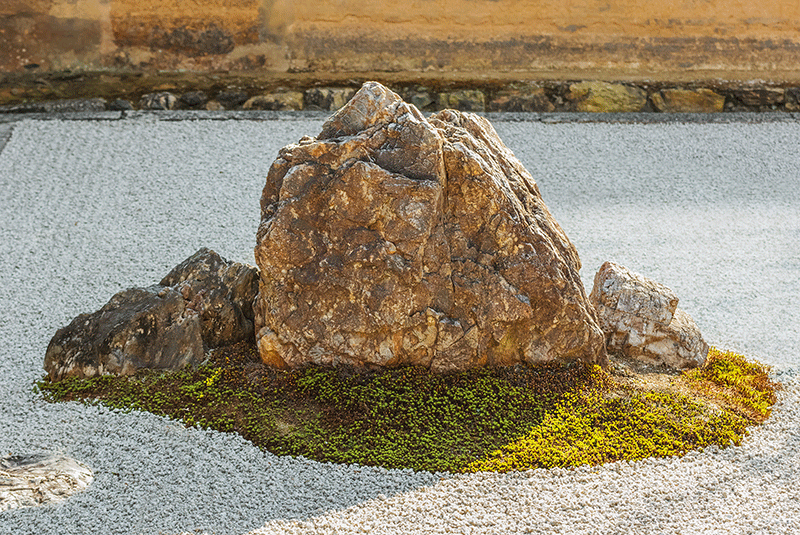
6. Its final lesson
And the gigglers and camera-clickers, the selfie-snappers and rock-counters, are all part of this completion. In their inescapable reality, they embody a much larger meaning: You must embrace them all — the monks and the moss and the trees, the schoolkids and the stones — to really be there, to be whole.
7. The way it teaches you how to appreciate Kyoto
And this is why I love to visit Ryoanji —and to take visitors there — as soon as I arrive in Kyoto. The rock garden doesn’t yield its essence easily. It makes me slow down, focus, and absorb. It makes me filter out all the distractions. It makes me really see, externally and internally.
And this is the fundamental lesson I need to relearn whenever I visit Kyoto: Because like Ryoanji, the 21st-century city doesn’t yield its ancient treasures promiscuously. It challenges you to find them for yourself, and in yourself. The best way to appreciate contemporary Kyoto is to view it, live it, through the ancient, timeless eyes and soul-heart-mind of Ryoanji.
This Valentine’s Day, as I celebrate Ryoanji and Delos and the greater glories of which they are but a part, I’m so grateful for the way that travel has opened my heart. Just as I was half a century before, I’m exhilarated by the wonders that await as soon as I set foot out the door.
And I’m grateful to you for sharing this romance of travel with me. May Cupid’s arrows bless you — and all of us — on every journey!
Yours in abiding wanderlust,
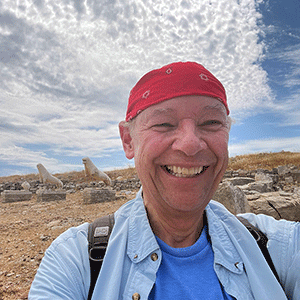
Don George
If you wish to explore the ancient wonders of Delos or the peaceful atmosphere of Ryoanji, reach out to our team at 888-570-7108 or contact an expert here.
Thank you, Don for these lovely words and images. One of these days, I’m going to visit those two spots, preferably with YOU as my trip leader. Meanwhile, I wish you Happy Travels in 2025!
Thank you, Don! I fell in love with both Delos and Ryoanji merely from your descriptions! Please keep spreading that love!
My husband and I first visited Ryoanji in 1976. We sat there alone without any other and contemplated its beauty. We don’t recall seeing moss around the rocks and wondered if it detracts from the tranquility and beauty of the gardens as a whole. When was it added? The first memory is still crystal clear in our minds. Despite several revisits to this captivating city, we have not been back to Ryoanji.
Dear Gloria, Thank you so much for your note! I first visited Ryoanji one year after you, in 1977, and according to my description from that time, there was moss around the rocks even then. For me, at least, the soft, springy moss doesn’t detract in any way from the tranquility and beauty of the garden but rather enhances that tranquility and beauty. I hope you can return to Ryoani on your next visit. It is still a singularly transporting place! Best wishes! — Don

